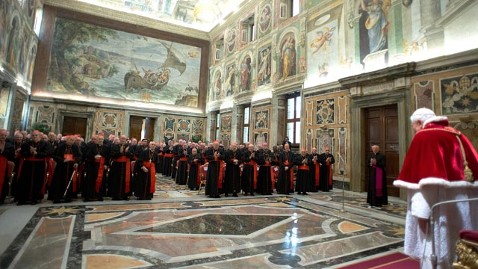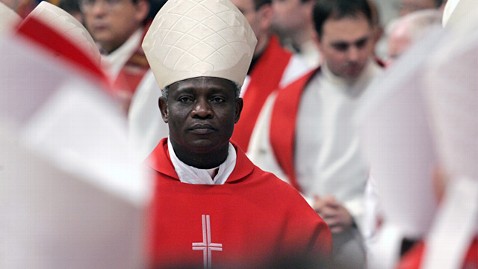When it comes to critical elements of the sequester timeline, not much is known -- because federal agencies have been tight lipped.
Asked when specific effects will be felt, officials at three federal departments declined to discuss the timing of sequester cuts and their consequences. Some departments were waiting for President Obama's Friday night sequester order and subsequent guidance they expected to receive from the Office of Management and Budget before talking about what would and wouldn't happen and when.
Read more: 57 Terrible Consequences of the Sequester
"There's no calendar of dates for specific actions or cuts on specific dates," Department of Health and Human Services public affairs officer Bill Hall told ABC News. "Again, these cuts need to be applied equally across all agency programs, activities and projects. There will be wide variation on when impacts will occur depending on a given program."
Some cuts won't be felt for a while because they have to do with government layoffs, which require 30 days notice, in most cases.
For instance, the Federal Aviation Administration won't begin layoffs until at least April 7, one FAA official estimated.
But some cuts don't involve furloughs, and could conceivably be felt immediately.
The Department of Homeland Security declined to comment on the timeline of layoffs to cybersecurity contractors and first responders funded through states, as well as limited Coast Guard operations and cuts to FEMA disaster relief.
The Department of Housing and Urban Development said it could not comment on cuts to housing vouchers, rent assistance for AIDS patients, maintenance for housing projects.
Andrew Harrer/Bloomberg/Getty Imag
Sequestration Deadline: Obama Meets With Leaders Watch Video
Sequester Countdown: The Reality of Budget Cuts Watch Video
The Department of Health and Human Services declined to discuss the specific timing of cuts to Head Start services, low-income mental-health services, AIDS/HIV testing, and inpatient substance-abuse treatment.
Read More: Automatic Cuts Could Hurt on Local Level
So even as the sequester hits, we still don't know when some of its worst effects will be felt.
Here's what we do know:
What Will Happen Saturday
 Air Force Training. At a briefing Friday, Deputy Defense Secretary Ashton Carter warned that "effective immediately, Air Force flying hours will be cut back."
Air Force Training. At a briefing Friday, Deputy Defense Secretary Ashton Carter warned that "effective immediately, Air Force flying hours will be cut back."
More from Carter, via ABC News' Luis Martinez: "What does that mean for national security? What it means is that as the year goes on, apart from Afghanistan, apart from nuclear deterrence through two missions we are strictly protecting, the readiness of the other units to respond to other contingencies will gradually decline. That's not safe. And that we're trying to minimize that in every way we possibly can."
 Closed Doors at the Capitol. ABC News' Sunlen Miller reports that Capitol Police issued a memo announcing it would have to close some entrances to the Capitol, writing: "At this time it is anticipated that the U.S. Capitol Police will be required to close some entrance doors and exterior checkpoints, and either suspend or modify the hours of operation for some of the U.S. Capitol Complex posts located inside and outside of the CVC and Office Buildings."
Closed Doors at the Capitol. ABC News' Sunlen Miller reports that Capitol Police issued a memo announcing it would have to close some entrances to the Capitol, writing: "At this time it is anticipated that the U.S. Capitol Police will be required to close some entrance doors and exterior checkpoints, and either suspend or modify the hours of operation for some of the U.S. Capitol Complex posts located inside and outside of the CVC and Office Buildings."
 Capitol Janitor Furloughs. After President Obama warned that janitors at the Capitol will be furloughed, ABC News' Sunlen Miller reported that was not entirely true: The Senate sergeant at arms, Terrance Gainer, told ABC News that no full-time salaried Capitol Police officers would face furloughs or layoffs at this time. They will, however, see a "substantial reduction in overtime," Gainer told ABC News.
Capitol Janitor Furloughs. After President Obama warned that janitors at the Capitol will be furloughed, ABC News' Sunlen Miller reported that was not entirely true: The Senate sergeant at arms, Terrance Gainer, told ABC News that no full-time salaried Capitol Police officers would face furloughs or layoffs at this time. They will, however, see a "substantial reduction in overtime," Gainer told ABC News.
 Delayed Deployment for USS Truman Aircraft Carrier. This has already happened, the Associated Press reported Friday morning: "One of the Navy's premiere warships, the aircraft carrier USS Harry S. Truman, sits pier-side in Norfolk, Va., its tour of duty delayed. The carrier and its 5,000-person crew were to leave for the Persian Gulf on Feb. 8, along with the guided-missile cruiser USS Gettysburg."
Delayed Deployment for USS Truman Aircraft Carrier. This has already happened, the Associated Press reported Friday morning: "One of the Navy's premiere warships, the aircraft carrier USS Harry S. Truman, sits pier-side in Norfolk, Va., its tour of duty delayed. The carrier and its 5,000-person crew were to leave for the Persian Gulf on Feb. 8, along with the guided-missile cruiser USS Gettysburg."












